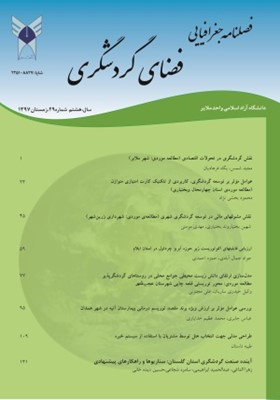بررسی عوامل مؤثر بر ارزش ویژه برند مقصد توریسم درمانی بیمارستان آتیه در شهر همدان
محورهای موضوعی :
مربوط به گردشگری
عباس جابری
1
,
محمداعظیم خدایاری
2
1 - 1- دانشجوی کارشناسی ارشد مدیریت بازرگانی گرایش بازاریابی دانشگاه آزاد اسلامی واحد ملایر
2 - استادیار و عضو هیات علمی گروه مدیریت دانشگاه آزاد اسلامی واحد ملایر
تاریخ دریافت : 1398/01/17
تاریخ پذیرش : 1398/01/17
تاریخ انتشار : 1397/12/01
کلید واژه:
ارزش ویژه برند,
آگاهی از برند,
تصویر برند,
توریسم درمانی,
وفاداری به برند,
کیفیت ادراک شده,
چکیده مقاله :
ارزش ویژه برند مقصد گردشگری سلامت عبارت است از مجموع داراییهای (یا بدهیهای) برند در رابطه با نام و سمبل مقصد گردشگری که موجب تغییراتی در ارزش خدمات و تجاربی که در آنجا فراهم میشود تعیین میگردد. با توجه به تفاوتهای فرهنگی، اجتماعی و خصوصیات مقصدهای گردشگری ایران، در این پژوهش سعی شده است اندازهگیری ارزش ویژه برند (قدرت برند) یک مقصد گردشگری از دیدگاه گردشگران سلامت با توجه به مدل کونکینک (2007)، برگرفته از مدل آکر مورد بررسی قرار گیرد که البته در مدل مورد استفاده به هر دو بعد رفتاری و ادراکی توجه میشود. بنابراین تحقیق حاضر قصد دارد مدل آکر را در کشور ایران و روی مقصد گردشگری سلامت بیمارستان آتیه شهر همدان مورد بازبینی قرار دهد. با توجه به اینکه هدف اصلی آن بررسی تأثیر متغیرهای مستقل (یعنی تصویر برند، آگاهی از برند، کیفیت ادراک شده و وفاداری به برند) بر متغیر وابسته(یعنی ارزش ویژه برند) است. این تحقیق از نوع همبستگی و از لحاظ هدف کاربردی و از لحاظ اجرا یا استراتژی، توصیفی از نوع پیمایشی است. نتایج حاصل از تحقیق نشان داده است که هر چهار عامل تصویر برند، وفاداری به برند، کیفیت ادراک شده و آگاهی به برند مقصد گردشگری به صورت مستقیم بر ارزش ویژه برند بیمارستان آتیه در شهر همدان تأثیر دارند و از نظر اهمیت، کیفیت ادراک شده مهمترین عامل تأثیرگذار شناخته شده است.
چکیده انگلیسی:
Considering the cultural and social characteristics of tourism destinations, the researchers of the present study tried to measure the brand equity (brand power) of a tourist destination from the perspective of health tourists based on the Kunkink Model (2007) which is taken from the Aker Model, in which both behavioral and perceptual dimensions have been considered. Therefore, the present study intends to review the Aker Model in Iran and investigate its application in the health tourism destination of Hamadan. Based on the main purpose of this study, the effect of brand image, brand awareness, perceived quality and brand loyalty (i.e., brand equity) as the independent variables on the particular value of the Atieh hospital brand in Hamadan which is the dependent variable was investigated. The results of the study showed that in terms of importance, the perceived quality was the most important factor of impact.
منابع و مأخذ:
جهانیان. منوچهر، زندی. ابتهال، گردشگری حامی فقرا، نشر جهاد دانشگاهی، 1389.
رنجبریان. بهرام، زاهدی. محمد، شناخت گردشگری، نشر چهار باغ 1388.
زارعی. عظیم، قربانی. فاطمه، پدرام نیا، مینو(1391)، "عوامل مؤثر بر واکنشهای رفتاری بازدیدکنندگان از مقصدهای گردشگری"، فصلنامه پژوهشی مطالعات گردشگری سال هفتم، شماره 20
کیانی. زهره، مجموعه مقالات سمینار تغیرات محیطی توسعه گردشگری و کاهش فقر، مقاله برند مقصد گردشگری و نقش آن در وحدت ذی نفعان صنعت گردشگری، ص333، نشر سازمان انتشارات جهاد دانشگاهی، 1387.
Aaker,D. (1991). Managing Brand Equity: Capitalizing on the Value of the Brand Name. New York ; The Free press
Etchner, C. M. and Ritchie, J. R. B. (1993), The measurement of destination image: an empirical assessment. In Hankinson,G. (2005). Destination brand images: a business tourism perspective, Journal of Services Marketing 19/1 24-32
Hankinson, G. (2005). Destinations brand images: a business tourism perspective, Journal of Servies Marketing 19/1 24-32.
Hankinson,G. , Walmsley, D. J. and Jenkins, J. M. (1993), The brand images of tourism destinatons: a study of the saliency of organic images, The Journa of product and Brand Management 2004, vol. 31, no. I,pp. 6-14.
Kapferer, J. N. (1998), Strategic brand management, London: Kogn Page
Keller, K. l. (1993). Conceptualizing, Measuring and Managing Customer-Based Brand Equity. Journal of Marketing,57, 1-22
Keller,k. l. (2003). Strategic Brand Management: Building, Measuring, and Managing Brand Equity (2nd ed). Upper Saddle River, NJ: Peasrson Education.
Konecnik, M., & Gatner, W. C. (2007) Customer-Based Brand Equity for a Destination Annals of Tourism Research,34(2) 400-421.
Parasuramans, A., Zetihmal, V. A. , Berry, (1988), SeRVQuAL: A Multiple-Itern Scale for Measuring Customer Perceptions of Service Quality, Journal of Retailing, 12-40.
Richie, J. R. B, & Crouch, G. I, (2003). The competitive destination : A sustainable tourism perpective. Wallingfard, UK: CABL P21-23.
Slater, S. F., and Olson, E. M. (2001).„Marketing‟s Contribution to the Implementation of Business Strategy: An Empirical Analysis‟. Strategic Management Journal. 22, 1055-1067.
Wong, K. K. F., Kwan, C. (2001). An analysis of the competitive strategies of hotels and travel agents in Hong Kong and Singapore. International Journal of Contemporary Hospitality Management 13 (6), 293–303.
Walmsley, D. J. and Jenkins, J. M. (1993), Appraisive image of tourist areas: an application of personal construts. In Hankinson,G. (2005). Destination brand images: a business tourism perspective, Journal of Services Marketing 19/1 24-32
Walmsley, D. J. and Young, M. (1998), Evaluative images and tourism: the use of personal constructs to describe the structure of destination images. In Hankinson, G. (2005). Destination brand images: a business tourism perspective, Journal of Services Marketing 19/1 24-32
Yoo, B. , Donthu, N. , & Lee, S. (2000). An Examination of Selected Marketing Mix Elements and Brand Journal of Marketing Research, 24, 258-270.
Zeithaml, V. A.(1988), Consumer Perception of Price, quality, and value: a meansend model and synthesis of evidence, Journal of Marketing, 52(3) 2-22
_||_

